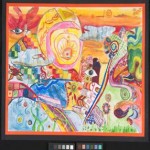OUT OF
ART INTO LITERACY
Learning Gallery
13 September – 5 December 2010
 London primary school children are to have their creative writing displayed at the
London primary school children are to have their creative writing displayed at the
National Gallery this autumn in a unique exhibition.
Out of Art into Literacy celebrates the outcomes of two innovative National Gallery
education projects: Into the Frame and Out of Art into Storytelling. Both projects
enabled teachers to explore the potential of using Gallery paintings to inspire their
pupils’ discussion and writing inside and outside the classroom.
Examples of oral storytelling, animation, writing and mixed-media artwork from a
selection of the participating schools will be on show. National Gallery paintings that
inspired the children include Bathers at Asnières (1884) by Georges Seurat, Bacchus and
Ariadne (1520–3) by Titian, Tobias and the Angel (1470–75) by the workshop of Verrocchio
and An Experiment on a Bird in the Air Pump (1768) by Joseph Wright ‘of Derby’.
 The projects began when 20 teachers from 10 London schools (all performing below
The projects began when 20 teachers from 10 London schools (all performing below
the floor Sats target) were invited to the Gallery to learn how to use the paintings to
stimulate learning across the curriculum. The aim of the projects was to develop children’s
confi dence and skills in reading and responding to paintings through talk and drama,
as a precursor to telling their own versions of the stories orally, visually and in writing.
Over the course of the project, 1,200 children took part from four London boroughs.
Following two days of training at the National Gallery participating teachers applied
and developed their thinking and practice with their pupils. Six months later they
returned to the Gallery to share the children’s experiences as well as their own
refl ections on working in this way.
Framed, a book by the celebrated children’s author Frank Cottrell Boyce, was central
to the fi rst project, as National Gallery paintings are woven through the narrative.
Boyce worked with the teachers as a group, and subsequently with all 600 children
over the course of the project.
The second project, Out of Art Into Storytelling, involved pupils ‘jumping into the
frame’ through dialogue and role-play, as a way in to telling their own versions of the stories represented in the paintings, first orally and then in other media. The second phase of this project supported pupils in transferring these skills of ‘reading’ paintings and oral storytelling to works with no known narrative. By exploring these paintings through careful looking, dialogue and role-play, the pupils developed story seeds in their imaginations and created their own narratives.
 All of the children visited the National Gallery during the course of the projects to see what had become ‘their’ paintings; many have returned with their families at weekends and school holidays.
All of the children visited the National Gallery during the course of the projects to see what had become ‘their’ paintings; many have returned with their families at weekends and school holidays.
One participating pupil said, ‘I’m looking forward to writing this week. I have never felt like this.’
Ali Mawle, National Gallery Head of Schools, said, ‘It has been transformational for many of the teachers and pupils involved.
Teachers have captured or recaptured the enjoyment and value of talk and drama to explore the rich context presented by a narrative painting. Children look at National Gallery paintings differently now – with confi dence and as a source of stories for them to tell. It has been amazing to see the passion that has been ignited.’
A teacher said, ‘Lessons are enjoyable to teach, resource-light and have produced the best writing results I have seen.’
The exhibition and accompanying fi lm celebrate the pupils’ work and demonstrate, as a Cambridge University external
evaluation report confi rmed, the power of visual art to transform children’s storytelling. The fi lm will be available to view at www.nationalgallery.org.uk/literacy for when the exhibition opens.

